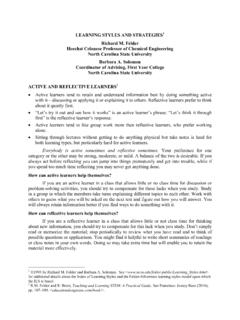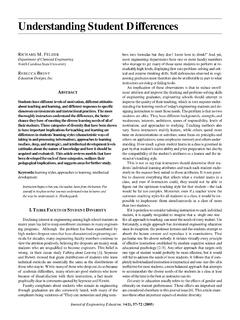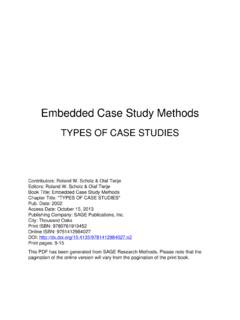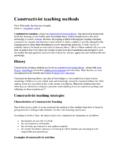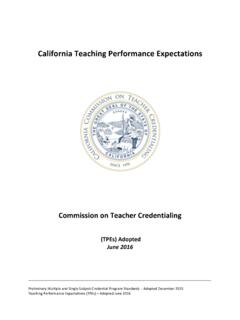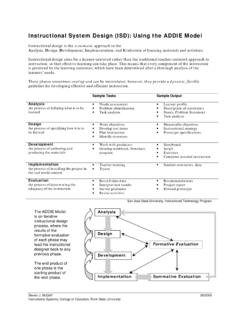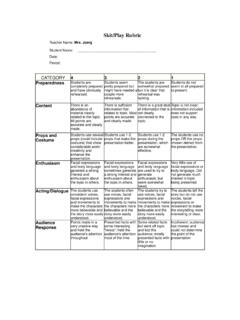Transcription of INDUCTIVE TEACHING AND LEARNING METHODS: …
1 1 INDUCTIVE TEACHING AND LEARNING methods : DEFINITIONS, COMPARISONS, AND RESEARCH BASES* Michael J. Prince Bucknell University Richard M. Felder North Carolina State University To state a theorem and then to show examples of it is literally to teach backwards. (E. Kim Nebeuts) ABSTRACT Traditional engineering instruction is deductive, beginning with theories and progressing to applications of those theories. Alternative TEACHING approaches are more INDUCTIVE . Topics are introduced by presenting specific observations, case studies or problems, and theories are taught or the students are helped to discover them only after the need to know them has been established.
2 This study reviews several of the most commonly used INDUCTIVE TEACHING methods , including inquiry LEARNING , problem-based LEARNING , project-based LEARNING , case-based TEACHING , discovery LEARNING , and just-in-time TEACHING . The paper defines each method, highlights commonalities and specific differences, and reviews research on the effectiveness of the methods . While the strength of the evidence varies from one method to another, INDUCTIVE methods are consistently found to be at least equal to, and in general more effective than, traditional deductive methods for achieving a broad range of LEARNING outcomes. I.
3 INTRODUCTION A. Two Approaches to Education Engineering and science are traditionally taught deductively. The instructor introduces a topic by lecturing on general principles, then uses the principles to derive mathematical models, shows illustrative applications of the models, gives students practice in similar derivations and applications in homework, and finally tests their ability to do the same sorts of things on exams. Little or no attention is initially paid to the question of why any of that is being done what real-world phenomena can the models explain, what practical problems can they be used to solve, and why the students should care about any of it.
4 The only motivation to learn that students get if they get any at all is suggestions that the material will be important later in the curriculum or in their careers. A well-established precept of educational psychology is that people are most strongly motivated to learn things they clearly perceive a need to know [1]. Simply telling students that they will need certain knowledge and skills some day is not a particularly effective motivator. A preferable alternative is INDUCTIVE TEACHING and LEARNING . Instead of beginning with general principles and eventually getting to applications, the instruction begins with specifics a set of observations or experimental data to interpret, a case study to analyze, or a complex real-world problem to solve.
5 As the students attempt to analyze the data or scenario or solve the problem, * J. Engr. Education, 95(2), 123 138 (2006). 2 they generate a need for facts, rules, procedures, and guiding principles, at which point they are either presented with the needed information or helped to discover it for themselves. INDUCTIVE TEACHING and LEARNING is an umbrella term that encompasses a range of instructional methods , including inquiry LEARNING , problem-based LEARNING , project-based LEARNING , case-based TEACHING , discovery LEARNING , and just-in-time TEACHING . These methods have many features in common, besides the fact that they all qualify as INDUCTIVE .
6 They are all learner-centered (aka student-centered), meaning that they impose more responsibility on students for their own LEARNING than the traditional lecture-based deductive approach does. They are all supported by research findings that students learn by fitting new information into existing cognitive structures and are unlikely to learn if the information has few apparent connections to what they already know and believe. They can all be characterized as constructivist methods , building on the widely accepted principle that students construct their own versions of reality rather than simply absorbing versions presented by their teachers.
7 The methods almost always involve students discussing questions and solving problems in class (active LEARNING ), with much of the work in and out of class being done by students working in groups (collaborative or cooperative LEARNING ). The defining characteristics of the methods and features that most of them share are summarized in Table 1. Table 1. Features of Common INDUCTIVE instructional methods Method Feature Inquiry Problem-based Project-based Case- based Discovery JiTT Questions or problems provide context for LEARNING 1 2 2 2 2 2 Complex, ill-structured, open-ended real-world problems provide context for LEARNING 4 1 3 2 4 4 Major projects provide context for LEARNING 4 4 1 3 4 4 Case studies provide context for LEARNING 4 4 4 1 4 4 Students discover course content for themselves 2 2 2 3 1 2 Students complete & submit conceptual exercises electronically.
8 Instructor adjusts lessons according to their responses 4 4 4 4 4 1 Primarily self-directed LEARNING 4 3 3 3 2 4 Active LEARNING 2 2 2 2 2 2 Collaborative/cooperative (team-based) LEARNING 4 3 3 4 4 4 1 by definition, 2 always, 3 usually, 4 possibly There are also differences among the different INDUCTIVE methods . The end product of a project-based assignment is typically a formal written and/or oral report, while the end product of a guided inquiry may simply be the answer to an interesting question, such as why an egg takes longer to boil at a ski resort than at the beach and how frost can form on a night when the temperature does not drop below freezing.
9 Case-based instruction and problem-based LEARNING involve extensive analyses of real or hypothetical scenarios while just-in-time TEACHING may simply call on students to answer questions about readings prior to hearing about the content of 3 the readings in lectures. However, the similarities trump the differences, and when variations in how the methods are implemented are taken into account many of the differences disappear altogether. Although we just claimed that INDUCTIVE methods are essentially variations on a theme, they do not appear that way in the literature. Each method has its own history, research base, guidebooks, proponents, and detractors, and a great deal of confusion exists regarding what the methods are and how they are interrelated.
10 Our objective in this paper is to summarize the definitions, foundations, similarities, and differences among INDUCTIVE LEARNING methods and to review the existing research evidence regarding their effectiveness. Before we begin our review, we will attempt to clarify two points of confusion that commonly arise in discussions of INDUCTIVE methods . Is INDUCTIVE LEARNING really INDUCTIVE ? In practice, neither TEACHING nor LEARNING is ever purely INDUCTIVE or deductive. Like the scientific method, LEARNING invariably involves movement in both directions, with the student using new observations to infer rules and theories (induction) and then testing the theories by using them to deduce consequences and applications that can be verified experimentally (deduction).
